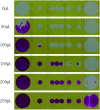Three-dimensional paper-based microfluidic electrochemical integrated devices (3D-PMED) for wearable electrochemical glucose detection
- PMID: 35515907
- PMCID: PMC9060762
- DOI: 10.1039/c8ra09157a
Three-dimensional paper-based microfluidic electrochemical integrated devices (3D-PMED) for wearable electrochemical glucose detection
Abstract
Wearable electrochemical sensors have attracted tremendous attention in recent years. Here, a three-dimensional paper-based microfluidic electrochemical integrated device (3D-PMED) was demonstrated for real-time monitoring of sweat metabolites. The 3D-PMED was fabricated by wax screen-printing patterns on cellulose paper and then folding the pre-patterned paper four times to form five stacked layers: the sweat collector, vertical channel, transverse channel, electrode layer and sweat evaporator. A sweat monitoring device was realized by integrating a screen-printed glucose sensor on polyethylene terephthalate (PET) substrate with the fabricated 3D-PMED. The sweat flow process in 3D-PMED was modelled with red ink to demonstrate the capability of collecting, analyzing and evaporating sweat, due to the capillary action of filter paper and hydrophobicity of wax. The glucose sensor was designed with a high sensitivity (35.7 μA mM-1 cm-2) and low detection limit (5 μM), considering the low concentration of glucose in sweat. An on-body experiment was carried out to validate the practicability of the three-dimensional sweat monitoring device. Such a 3D-PMED can be readily expanded for the simultaneous monitoring of alternative sweat electrolytes and metabolites.
This journal is © The Royal Society of Chemistry.
Conflict of interest statement
There are no conflicts to declare.
Figures






Similar articles
-
Wearable Healthcare Monitoring Based on a Microfluidic Electrochemical Integrated Device for Sensing Glucose in Natural Sweat.Sensors (Basel). 2022 Nov 19;22(22):8971. doi: 10.3390/s22228971. Sensors (Basel). 2022. PMID: 36433566 Free PMC article.
-
A highly integrated sensing paper for wearable electrochemical sweat analysis.Biosens Bioelectron. 2021 Feb 15;174:112828. doi: 10.1016/j.bios.2020.112828. Epub 2020 Nov 19. Biosens Bioelectron. 2021. PMID: 33250335
-
Development of a wearable microfluidic amperometric sensor based on spatial three-electrode system for sweat glucose analysis.Talanta. 2025 Oct 1;293:128101. doi: 10.1016/j.talanta.2025.128101. Epub 2025 Apr 7. Talanta. 2025. PMID: 40215721
-
Recent Advances in Two-Dimensional MXene-Based Electrochemical Biosensors for Sweat Analysis.Molecules. 2023 Jun 7;28(12):4617. doi: 10.3390/molecules28124617. Molecules. 2023. PMID: 37375172 Free PMC article. Review.
-
Graphene-interfaced flexible and stretchable micro-nano electrodes: from fabrication to sweat glucose detection.Mater Horiz. 2023 May 9;10(5):1580-1607. doi: 10.1039/d2mh01517j. Mater Horiz. 2023. PMID: 36880340 Review.
Cited by
-
Electrospun nanofiber-based glucose sensors for glucose detection.Front Chem. 2022 Aug 11;10:944428. doi: 10.3389/fchem.2022.944428. eCollection 2022. Front Chem. 2022. PMID: 36034672 Free PMC article. Review.
-
Fundamental Study of a Wristwatch Sweat Lactic Acid Monitor.Biosensors (Basel). 2024 Apr 10;14(4):187. doi: 10.3390/bios14040187. Biosensors (Basel). 2024. PMID: 38667180 Free PMC article.
-
Surface Wettability for Skin-Interfaced Sensors and Devices.Adv Funct Mater. 2022 Jul 4;32(27):2200260. doi: 10.1002/adfm.202200260. Epub 2022 Apr 28. Adv Funct Mater. 2022. PMID: 36176721 Free PMC article.
-
Dual-signal readout paper-based wearable biosensor with a 3D origami structure for multiplexed analyte detection in sweat.Microsyst Nanoeng. 2023 Mar 28;9:36. doi: 10.1038/s41378-023-00514-2. eCollection 2023. Microsyst Nanoeng. 2023. PMID: 36999140 Free PMC article.
-
Craft-and-Stick Xurographic Manufacturing of Integrated Microfluidic Electrochemical Sensing Platform.Biosensors (Basel). 2023 Mar 31;13(4):446. doi: 10.3390/bios13040446. Biosensors (Basel). 2023. PMID: 37185521 Free PMC article.
References
-
- Kim D.-H. Lu N. Ma R. Kim Y.-S. Kim R.-H. Wang S. Wu J. Won S. M. Tao H. Islam A. Yu K. J. Kim T.-i. Chowdhury R. Ying M. Xu L. Li M. Chung H.-J. Keum H. McCormick M. Liu P. Zhang Y.-W. Omenetto F. G. Huang Y. Coleman T. Rogers J. A. Science. 2011;333:838–843. doi: 10.1126/science.1206157. - DOI - PubMed
-
- Bariya M. Nyein H. Y. Y. Javey A. Nature Electronics. 2018;1:160–171. doi: 10.1038/s41928-018-0043-y. - DOI
-
- Mukhopadhyay S. C. IEEE Sens. J. 2015;15:1321–1330.
LinkOut - more resources
Full Text Sources
Other Literature Sources

